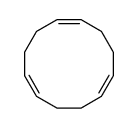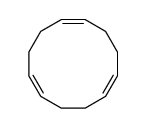1,2,5,6,9,10-Hexabromocyclododecane

1,2,5,6,9,10-Hexabromocyclododecane structure
|
Common Name | 1,2,5,6,9,10-Hexabromocyclododecane | ||
|---|---|---|---|---|
| CAS Number | 3194-55-6 | Molecular Weight | 641.695 | |
| Density | 2.1±0.1 g/cm3 | Boiling Point | 505.2±50.0 °C at 760 mmHg | |
| Molecular Formula | C12H18Br6 | Melting Point | 173-177 ºC | |
| MSDS | Chinese USA | Flash Point | 249.5±24.8 °C | |
| Symbol |


GHS08, GHS09 |
Signal Word | Warning | |
| Name | 1,2,5,6,9,10-Hexabromocyclododecane (HBCD) |
|---|---|
| Synonym | More Synonyms |
| Density | 2.1±0.1 g/cm3 |
|---|---|
| Boiling Point | 505.2±50.0 °C at 760 mmHg |
| Melting Point | 173-177 ºC |
| Molecular Formula | C12H18Br6 |
| Molecular Weight | 641.695 |
| Flash Point | 249.5±24.8 °C |
| Exact Mass | 635.650818 |
| LogP | 6.63 |
| Vapour Pressure | 0.0±1.2 mmHg at 25°C |
| Index of Refraction | 1.598 |
| Symbol |


GHS08, GHS09 |
|---|---|
| Signal Word | Warning |
| Hazard Statements | H361-H362-H410 |
| Precautionary Statements | P201-P260-P263-P273-P308 + P313-P391 |
| Personal Protective Equipment | Eyeshields;Gloves;type N95 (US);type P1 (EN143) respirator filter |
| Hazard Codes | Xi:Irritant |
| Risk Phrases | R36/37/38 |
| Safety Phrases | S22-S24/25 |
| RIDADR | 3077 |
| WGK Germany | 1 |
| RTECS | GU2302500 |
| Hazard Class | 9.0 |
| HS Code | 2903890090 |
|
~% 
1,2,5,6,9,10-He... CAS#:3194-55-6 |
| Literature: Journal of the Chemical Society [Section] C: Organic, , p. 474 - 479 |
|
~% 
1,2,5,6,9,10-He... CAS#:3194-55-6 |
| Literature: Journal of the Chemical Society [Section] C: Organic, , p. 474 - 479 |
| Precursor 2 | |
|---|---|
| DownStream 1 | |
| HS Code | 2903890090 |
|---|---|
| Summary | 2903890090. halogenated derivatives of cyclanic, cyclenic or cyclotherpenic hydrocarbons. VAT:17.0%. Tax rebate rate:13.0%. . MFN tariff:5.5%. General tariff:30.0% |
|
Levels and patterns of persistent organic pollutants (POPs) in tilapia (Oreochromis sp.) from four different lakes in Tanzania: geographical differences and implications for human health.
Sci. Total Environ. 488-489 , 252-60, (2014) In Tanzania fish is one of the most important protein sources for the rapidly increasing population. Wild fish is threatened by overfishing and pollution from agriculture, industries, mining, househol... |
|
|
Elucidating toxicological mechanisms of current flame retardants using a bacterial gene profiling assay.
Toxicol. In Vitro 29 , 2124-32, (2015) Flame retardants are ubiquitously used chemicals that have been shown to contaminate environments. Toxicological data is largely limited, with little insight into their molecular modes of action that ... |
|
|
Rapid screening and identification of multi-class substances of very high concern in textiles using liquid chromatography-hybrid linear ion trap orbitrap mass spectrometry.
J. Chromatogr. A. 1386 , 22-30, (2015) A new analytical method was established and validated for the analysis of 19 substances of very high concern (SVHCs) in textiles, including phthalic acid esters (PAEs), organotins (OTs), perfluorochem... |
| 1,2,5,6,9,10-hexabromo-cyclododecan |
| HBCD HT |
| Hexabromocyclododecane SP-75C |
| 1,2,5,6,9,10-Hexabromocyclododecane |
| CD-75 |
| MFCD00003716 |
| Cyclododecane,1,2,5,6,9,10-hexabromo |
| Hexabromocyclododecane |
| EINECS 221-695-9 |
| Cyclododecane, 1,2,5,6,9,10-hexabromo- |
| 1,2,5,6,9,10-Hexabromocyclododecane |
| HEXABROMOCYCLODODECANE HT |
| HBCD |
| L-12-TJ AE BE EE FE IE JE |
| 1,2-trans-5,6-cis-9,10-cis-hexabromo-cyclododecane |


 CAS#:257-24-9
CAS#:257-24-9